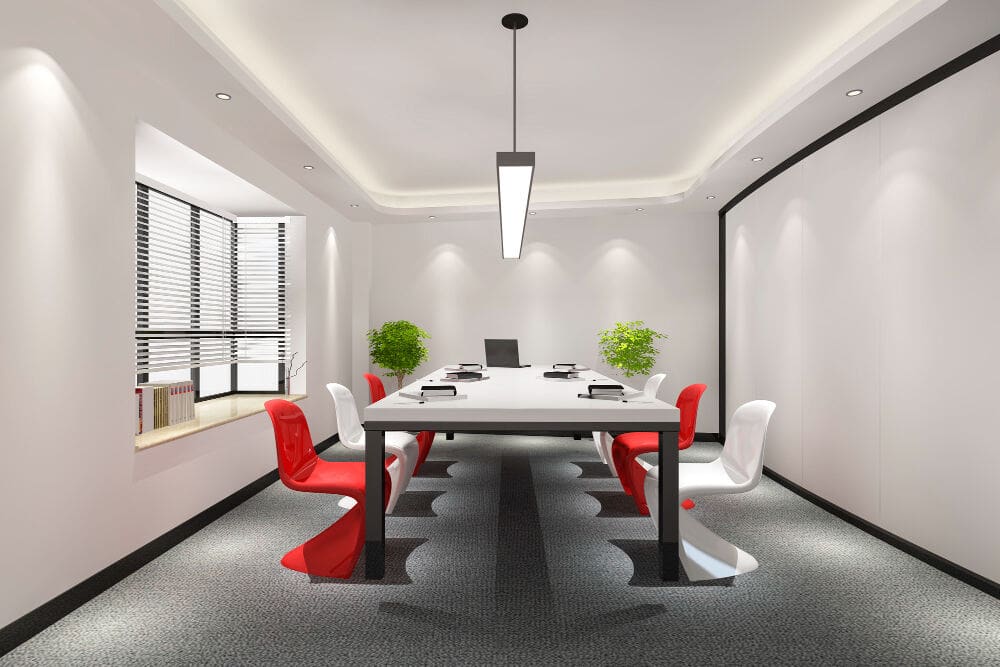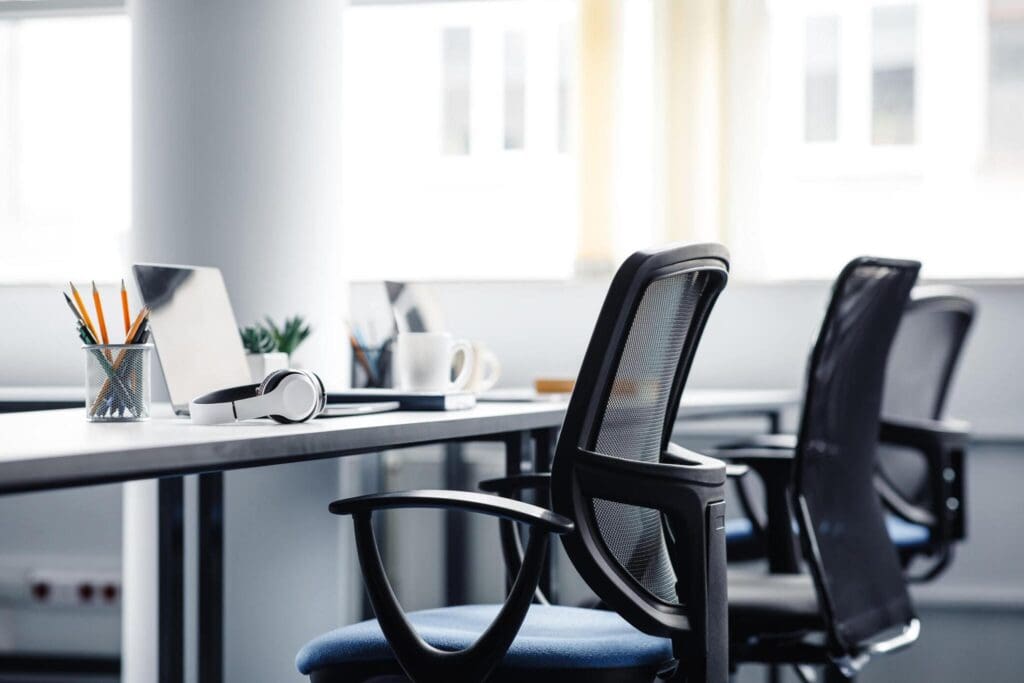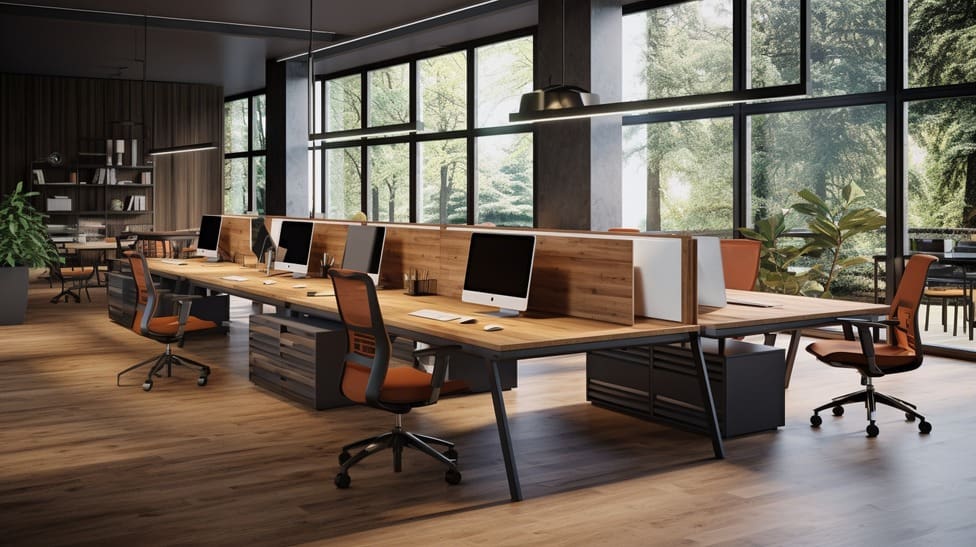Key Takeaways
How a Good Office Layout Optimizes Workflow
How to Arrange Your Modern Office Furniture for Optimal Workflow
Frequently Asked Questions

Maximizing space utilization is vital when arranging modern office furniture. Efficient use of space ensures that every inch of the office contributes to productivity. A well-organized office with modern office furniture enhances workplace satisfaction. Employees feel more comfortable and valued when their workspace is neat and functional, which is crucial for retaining talent in a competitive job market. Happy employees are more likely to stay with a company and perform better.
Thoroughly assessing your office space is essential for creating a well-organized, functional, and comfortable workspace with modern office furniture. This involves measuring the area accurately, identifying key areas within the office, and meticulously planning the layout.
Here’s how to do it:
The right modern office furniture creates an efficient and comfortable workspace. This involves prioritizing ergonomic designs for health, flexible options for adaptability, and a balance of aesthetics and functionality for an efficient and pleasant work environment.
Ergonomic furniture is essential for modern offices as it supports proper posture, reduces the risk of injuries and discomfort, and leads to higher productivity. Businesses that invest in ergonomic modern office furniture often see fewer employee absences. Key types of ergonomic furniture include chairs with lumbar support, adjustable desks, and footrests, all of which improve comfort, enhance focus, and increase overall employee well-being.
Flexible furniture options such as modular desks and adjustable chairs are highly adaptable, meeting the changing needs of various tasks and team sizes. These pieces are ideal for rapidly evolving businesses, as they maximize office space by allowing for multiple configurations.
Aesthetic and functionality should be balanced in office design. Attractive furniture creates a pleasant work environment, boosting morale and ensuring the workspace is practical and organized. Additionally, well-designed offices reflect a professional and efficient business image.
The arrangement of workstations in an office is crucial in maximizing space utilization, enhancing communication, and maintaining a productive work environment. Here are key aspects to consider when positioning workstations with modern office furniture:

Collaborative spaces are vital for fostering teamwork and innovation in any office. Properly designed areas with modern office furniture can significantly enhance productivity and creativity.
Effective meeting areas are crucial for encouraging collaboration and communication among team members. To create inviting and functional spaces, consider the following:
Breakout zones are essential for informal discussions and brainstorming sessions. These areas provide a relaxed environment where employees can engage in spontaneous collaboration. To design effective breakout zones:
Creative spaces are designed to inspire innovative thinking and problem-solving. These areas should be flexible and stimulating to encourage out-of-the-box thinking. Consider the following when setting up creative spaces:
An efficient office layout is essential for maintaining smooth movement and workflow. Here’s how to optimize traffic flow with modern office furniture.
Clear pathways are crucial to preventing congestion and ensuring easy movement throughout the office. Arrange furniture to keep main walkways free of obstructions, allowing employees to move freely between workstations and other areas. If the office space is compact, maintaining clear pathways helps ensure an efficient and safe working environment. Here are a few tips to achieve this:
Ensuring all areas are accessible to all employees, including those with disabilities, is crucial for inclusivity. Position furniture to allow sufficient space for wheelchairs and ensure all facilities are within easy reach. Businesses that prioritize accessibility create more inclusive and productive workplaces. Here’s how to enhance accessibility:
An efficient layout supports smooth movement and workflow. Position frequently used items and equipment within easy reach and arrange desks and chairs to facilitate quick access. With optimized office layouts, businesses can see improved efficiency and employee satisfaction. Consider these points for an efficient layout:
Proper lighting and ventilation are critical for a healthy and productive work environment. Here’s how to enhance these elements with modern office furniture.
Natural light boosts morale and productivity. Arrange desks and workstations near windows to maximize daylight exposure, and use glass partitions to allow light to flow through the office.
Complement natural light with artificial lighting to reduce eye strain and enhance productivity. Use modern office furniture with built-in lighting features, such as desks with task lighting. Install adjustable LED lighting that can be tailored to different tasks and times of day.
Good ventilation is crucial for a healthy office environment. Ensure air can circulate freely around furniture, and consider air purifiers or plants to improve air quality.
Personalizing workspaces can boost employee morale and productivity. Here’s how to achieve this:
Personalizing workspaces makes employees feel more comfortable and valued. Encourage employees to bring personal items like photos, plants, and decor. Provide options for customizing their workstations to create a personal touch.
Effective storage solutions keep workspaces organized and clutter-free. Use modern office furniture with built-in storage, such as desks with drawers and cabinets. Implement vertical storage solutions to maximize space.

In small spaces, prioritize multi-functional modern office furniture that maximizes space utilization. Consider vertical storage solutions and use light colors to make the space feel larger. Businesses in New Haven, CT, can benefit from these strategies to create efficient small offices.
Look for modular modern office furniture that can be easily reconfigured and expanded. Consider refurbishing existing furniture or buying second-hand pieces. New Haven, CT, businesses can save money while updating their office aesthetics and functionality.
Current trends include ergonomic designs, modular and flexible furniture, eco-friendly materials, and technology integration. Businesses in New Haven, CT that stay updated with these trends can create a modern and efficient office environment.
Prioritize ergonomic and multi-functional modern office furniture that fits the space. Consider storage solutions and aesthetics that blend with your home decor. In New Haven, CT, home offices should be functional and comfortable.
Maintaining modern office furniture involves regular cleaning and preventive care to ensure longevity. Use appropriate cleaning solutions for materials like wood, metal, or upholstery. Regularly check for and tighten any loose screws or bolts. Implement a maintenance schedule that includes periodic deep cleaning and inspections.
Transform your New Haven, CT, office with high-quality modern furniture from Stamford Office Furniture. Our range of ergonomic, flexible, and aesthetically pleasing furniture will enhance your office layout and improve workflow. We offer various modern office furniture, including desks, chairs, storage solutions, and collaborative furniture. Our experts will help you choose the best pieces to suit your office’s needs.
With years of experience helping businesses create efficient office environments, Stamford Office Furniture provides top-notch service and high-quality products for the modern worker.